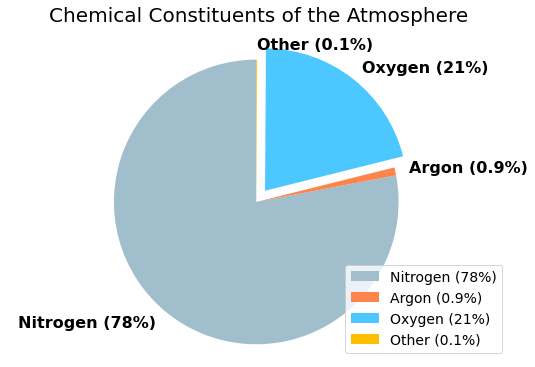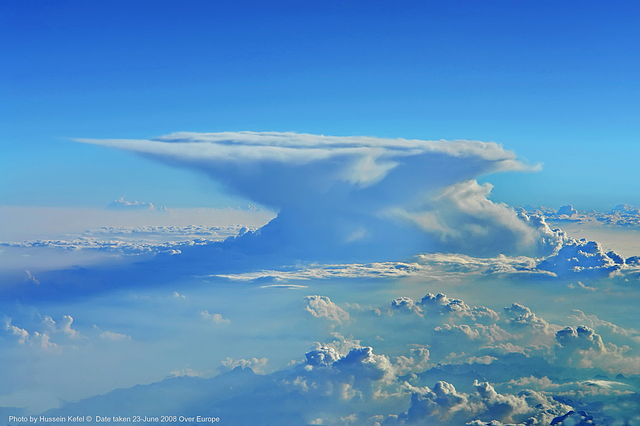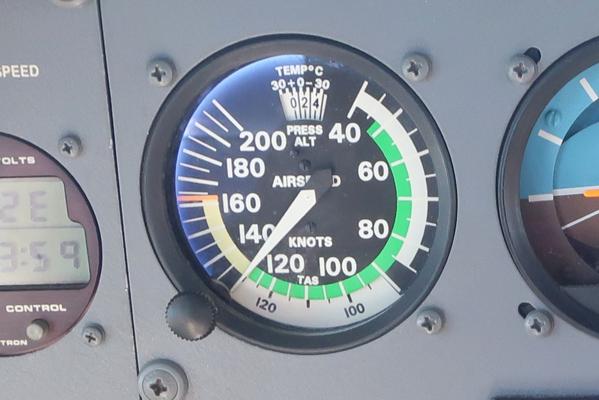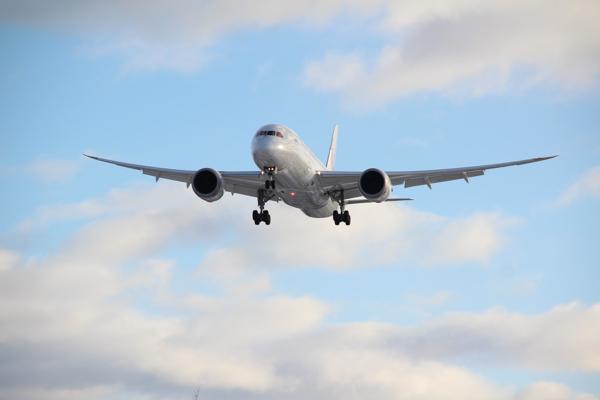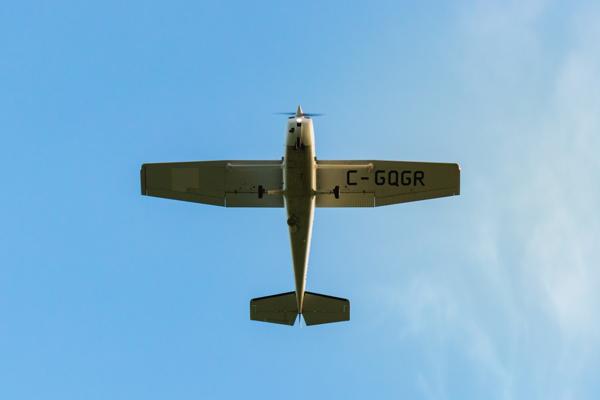The atmosphere surrounds us and is all around us. It is the envelope of air that allows life on Earth and is the fluid medium through which we fly. Aircraft flying within our atmosphere are subjected to the variations in pressure, density, temperature, and viscosity which characterise the various layers of the atmosphere.
These variations have a marked effect on the performance of an aircraft and for that reason it is important to have a working knowledge of the composition and characteristics of the atmosphere.
Chemical Composition of our Atmosphere
The previous post in this Principles of Flight series discussed the fact that air is a fluid, and as such has fluid properties like mass, pressure, and viscosity.
Air is a mixture of gasses; principally Nitrogen (78%) and Oxygen (21%). Argon makes us slightly less than 1%, and the remaining 0.1% is comprised of Carbon Dioxide, Helium, Neon, Methane, and Krypton.
It is important to recognise that this chemical composition is not evenly distributed. The various elements have different weights and as such rise or fall based on their relative density. Oxygen is relatively heavy and so is concentrated closer to the Earth's surface. The majority of the oxygen in the atmosphere is concentrated below 35 000 ft (10.7 km), which is approximately 10% of the height of the altitude designated as the start of space (Karmen Line).
Five Atmospheric Layers
There are five distinct layers making up our atmosphere. These layers are differentiated by their differing:
- thermal characteristics
- chemical composition
- movement, and
- density.
Troposphere
This is the name given to the lower atmosphere and the region in which almost all weather occurs. The troposphere begins at the Earth's surface and extends to a height of approximately 20 km at the equator. The height of the troposphere varies with latitude; from 20 km at the equator to 6 km at the North and South Pole.
The majority of air traffic operates in the troposphere, which is characterised by decreasing pressure, density and temperature with altitude. This is why it is advantageous for aircraft to operate at higher altitudes, as a decrease in air density means a reduction in drag and improved fuel efficiency.
Stratosphere
The stratosphere sits above the troposphere and extends to around 50 km above the surface of the Earth. This region is characterised by an increase in temperature with altitude, resulting from the heat released by the formation of Ozone. The temperature in the lower regions of the stratosphere is approximately -50ºC (-60ºF), while the upper regions are closer to -15ºC (5ºF).
The reverse in direction of the lapse rate (temperature change with altitude) between the stratosphere and troposphere means that a layer of warmer air is located above cooler air. This prevents convection into the upper altitudes and is responsible for the anvil-shaped tops of cumulonimbus clouds which marks the start of the stratosphere.
Mesosphere
This layer extends from about 50 km (31 miles) above the surface of the Earth to 85 km (53 miles), and is characterised by decreasing temperature with altitude. The stratosphere and mesosphere are considered to be the middle atmosphere.
Thermosphere
The thermosphere starts at approximately 85 km (53 miles) above the Earth's surface and extends to 600 km (375 miles). The International Space Station (ISS) orbits at 408 km which is well within the thermosphere. The Hubble Space Telescope orbits at approximately 550 km above the surface of the Earth, at the top of the Thermosphere.
Exosphere
The exosphere extends from about 600 km (375 miles) to 10 000 km (6 200 miles) above the surface of the Earth.
International Standard Atmosphere
Our atmosphere is in a constant state of flux due to both local and global weather phenomena. Local conditions vary all the time, both laterally along the surface of the Earth and vertically with altitude. This necessitates that a theoretical model of the atmosphere is used by aircraft designers and instrument manufacturers to develop the performance calculations shown in the Pilot Operating Handbook and as a reference for instruments such as the airspeed indicator, altimeter, and vertical speed indicator.
This atmosphere model is referred to as the International Standard Atmosphere and provides a mathematical model describing how pressure, temperature, density, and viscosity vary over a range of altitudes from sea level to 80 km.
Our Standard Atmosphere Calculator is a popular tool which outputs the relevant atmospheric properties given an altitude and temperature or temperature offset from standard.
Sea level standard conditions are an important set of atmospheric values that should be known by all pilots. This fictitious "standard day" is used among other things to calibrate airspeed indicators and altimeters based on the assumption that the aircraft is operating at sea level on a standard day.
| Temperature | 15°C |
| Pressure | 1013.25 hPa or 29.92 inHg |
| Density | 1.225 kg/m³ |
A standard temperature lapse rate exists where the temperature in the atmosphere is said to decrease from 15°C (59°F) at sea level at a rate of 1.98°C/1000 ft up to 36 000 ft where the temperature is approximately -56°C (-69°F). Thereafter the temperature is approximated to be constant up to 80 000 ft.
A pressure lapse rate of approximately 1 hPa per 30 ft (1 inHg per 1000 ft) in the lower atmosphere provides a means to approximate the static pressure change with altitude.
Any time the atmosphere differs from this standard atmosphere (most of the time) there will be a discrepancy in the assumed and actual conditions and a correction will need to be made. This takes the form of an adjustment of the Kollsman window on an altimeter, or the conversion from indicated to true airspeed on the airspeed indicator.
This is also where the concepts of Pressure and Density altitude, and their implications must be well understood. Of particular importance is the role that increased temperatures plays in reducing the air density, and hence the performance of an aircraft. This is most vital when operating at high elevation airfields on a hot day. The loss in performance associated with high density altitudes was brought into sharp focus with the recent (July 2023) fatal crash of a light Cessna Twin as Santa Fe Regional airport. In this case the density altitude was greater than 9000 ft and the aircraft was unable to climb or maintain altitude on a single engine.
Factors Affecting Air Density
Air density is affected by changes in altitude, temperature, and humidity. It is important to understand how these atmospheric properties affect the air density, and therefore aircraft performance
Pressure
Decreasing pressure is associated with increasing altitude. At higher altitudes the air is able to expand and occupy a larger region. Decreasing pressure therefore results in decreased air density at a constant temperature.
Temperature
Increasing temperature results in a decrease in density at a constant pressure.
Since temperature and pressure both decrease with altitude, the drop in temperature associated with altitude gain works in opposition to the dropping pressure. However, the pressure drop with altitude dominates such that air density decreases with increasing altitude.
Humidity (Moisture)
In the preceding cases we have assumed that the air is perfectly dry. In reality there is always some amount of water vapour suspended in the air, which in cases where the humidity is high, has a non-negligible effect on the air density.
Water vapour is lighter than air; this means that humid or moist air is lighter than dry air. Therefore, the higher the humidity, the lower the air density.

